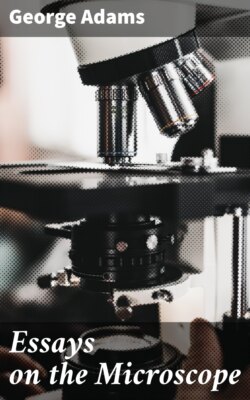Читать книгу Essays on the Microscope - George Comp Adams - Страница 44
На сайте Литреса книга снята с продажи.
TO USE THE SOLAR MICROSCOPE.
ОглавлениеMake a round hole in a window-shutter or window-board, that is opposite to the meridian sun, or as nearly so as possible, a little larger than the circle a b c; pass the mirror, N O P, through this hole, and apply the square plate to the shutter; then mark with a pencil the places which correspond to the two holes through which the screws are to pass; take away the microscope, and bore two holes at the marked places, large enough to admit the milled screws, d e, to pass through them. These screws are to pass from the outside of the shutter, to go through it, and being then screwed into their respective holes in the square plate, they will, when screwed home, hold it fast against the inside of the shutter, and thus support the microscope.
Another way, and perhaps more convenient, is to previously screw the two brass nuts, Fig. 13, to the shutter or window-board, at the inside at a suitable distance, to receive the two milled screws; these nuts will always be ready for use, and the operator may in a minute, within his room, fasten the plate, a b c, to the shutter by the two milled screws, being placed contrarywise.
Screw the conical tube, A B C D, to the circle, a b c, and then slide the tube, G, of the opake box into the cylindrical part, C D E F, of the body, if opake objects are to be examined; but if transparent objects are intended to be shewn, then place the tube Y, Fig. 2, within the tube C D E F. The room is to be darkened as much as possible, that no light may enter but what passes through the body of the microscope; for, on this circumstance, together with the brightness of the sun, the perfection and distinctness of the image in a great measure depend.
We shall first consider the microscope as going TO BE USED FOR OPAKE OBJECTS. Adjust the mirror, N O P, so as to receive the solar rays, by means of the two finger-screws or nuts, Q, R; the first, Q, turns the mirror to the right or left; the second, R, raises or depresses it: this you are to do, till you have reflected the sun’s light through the lens at A B, strongly upon a white-paper screen or cloth, from four to eight feet square (about the latter dimensions for transparent objects) placed from about five to eight feet distance from the window, and formed thereon a round spot of light: a white wainscot or wall at a suitable distance answers very well. An unexperienced observer will find it more convenient to obtain the light by first forming this spot, before he puts on either the opake box, or the tooth and pinion microscope, Fig. 2.
Now apply the opake box, and place the object between the plates at H; open the door, k i, and adjust the mirror, M, till you see you have illuminated the object strongly. If you cannot effect this by the screw S, you must move the screws Q, R, in order to get the light reflected strongly from the mirror, N O P, on the mirror M; without which the latter cannot illuminate the object. The object being strongly illuminated, shut the door, k i, and a distinct view of the object will soon be obtained on your screen, by adjusting the tubes V X, with the magnifiers, which is effected by moving them backwards or forwards.
A perfectly round spot of light cannot always be procured in northern latitudes, the altitude of the sun being often too low; neither can it be obtained when the sun is directly perpendicular to the front of the room. As the sun is continually changing its place, it will be necessary, in order to keep his rays full upon the object, to keep them continually directed through the axis of the instrument, by turning the two screws Q and R.
To view transparent objects, remove the opake box, and insert the tube, Y, of Fig. 2, in its place; put the slider, Fig. 3, into its place at n, a condenser, Fig. 4, at h, and the slider with the objects between the plates at m; then adjust the mirror, N O P, as before directed, by the screws, Q, R, so that the light may pass through the object; regulate the focus of the magnifier by the pinion, O. The most pleasing magnifiers in use are the fourth and fifth. The size of the object is generally from four to eight feet, and may be increased or diminished by altering the distance of the screen from the microscope; five or six feet is a convenient distance.
The effect by this sort of microscope is stupendous, and never fails to excite wonder in an observer at the first view, in seeing a flea, &c. augmented in appearance to SEVEN, EIGHT, or even TEN FEET in length, with all its colours, motions, and animal functions, distinctly and beautifully exhibited.
To examine transparent objects of a larger size, or to render the instrument what is usually called a megalascope, take out the slider, Fig. 3, from its place at n; screw the cell and lens, Fig. 6, into the hole at P, Fig. 2; remove the glass which is placed at h, and regulate the light and focus agreeable to the foregoing directions.
At C D, is placed a lens for increasing the density of the rays, for the purpose of burning or melting any fusible substance; this lens must be removed in most cases, lest the objects should be burnt. The intensity of the light is also varied by moving the tube G, and Fig. 2, Y, inwards or outwards.
